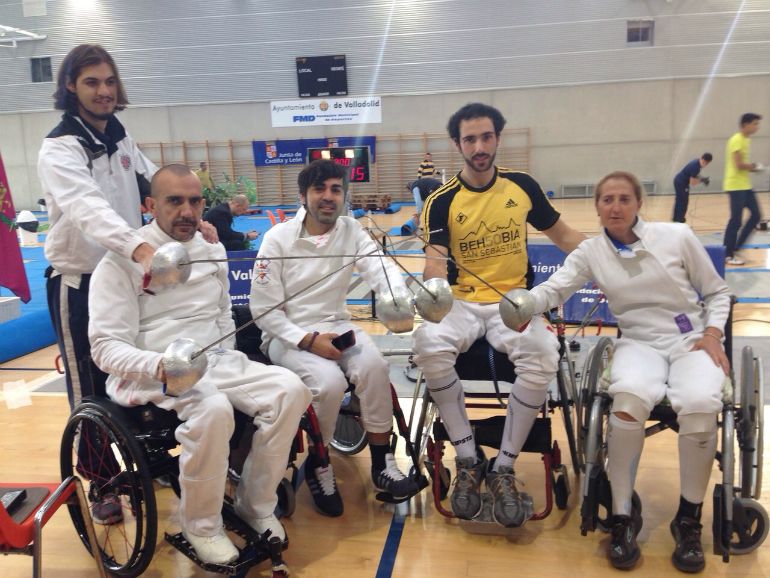Share:
Take it offline!
This Education in Motion resource is also available as a printable PDF.
Download PDF
The history of wheelchair fencing began in England in the 1950s at the Stoke Mandeville Hospital, where soldiers wounded in WW2 underwent recovery and rehabilitation.
After its debut at the 1960 Rome Olympics, it soon became a very popular all-round adapted sport that required not only physical strength, but also precision, technique and style.
Wheelchair fencing: A brief history
Sword fighting has been practised for thousands of years, but the sport of fencing, as we know it today came about in the nineteenth century, defined as the art of defence and attack with a sword. Baron Pierre de Coubertin, a passionate advocate of the sport, introduced it as a sports category in the first Olympic Games of the modern era. The women's category was incorporated in 1924.
Wheelchair fencing aims to maintain the spirit of its non-adapted format. The fact that it was considered something of a classical sport soon created an interest that led to it becoming one of the first ever Paralympic sports.
A new classification and scoring system was incorporated at the Seoul Olympics in 1988 in order to create a level playing field for athletes with different disabilities, one that is still in use today. Thanks to these new systems, the International Fencing Federation (FIE) began to implement a testing procedure specifically designed for wheelchair fencing referees, which led to a rise in the number of national and international championships.

Wheelchair fencing basic rules
In adapted fencing the competitors duel with their wheelchairs anchored into position on the ground, though this does not take away from the intensity or allure of the competition. In fact, it provides the competitors with greater upper body stability, which allows them to demonstrate a very high level of technique, requiring hand coordination, mobility and reflexes.
The length of the fencing area is determined at the beginning of the duel (in order to anchor the wheelchair) and is decided according to which competitor has the least reach with an extended arm, with the shorter of the two choosing whether to strategically elect either the shorter or longer distance.
As with conventional fencing, in wheelchair fencing the competitors are connected to an electronic signal box that registers when either one is touched by their opponent's weapon.
All competitors must be fully equipped with the requisite protective clothing to cover the face, torso, legs and hands.
The first to land five touches onto their opponent wins the match.
Competitors must never hurt the opponent and weapons must never be modified.
If a competitor has difficulty grasping or controlling the weapon by hand, it may also be attached to the arm.
The wheelchair must not be rigid and its height must be 53cm. The backrest must measure at least 15cm in height and be at 90º (with some exceptions), whilst the armrest on the opposite side must measure at least 10cm.
Although not mandatory, the cushion can measure up to a maximum height of 10cm.
The angle of the chair's wheels must also conform to officially defined measurements.
The different categories of wheelchair fencing
Wheelchair fencing can be practised by both men and women in wheelchairs, by amputees or by those with mild cerebral palsy. The same weapon categories apply to those used in classical fencing (foil, sabre or épée).
Classification of participants is based on a series of tests that assess the ability to laterally extend or incline the torso with or without a weapon. The movements that are taken into account are for technique and defence. The ability to extend the upper and lower back muscles and lateral balance with the arms tucked in with or without a weapon are all assessed.
The following scores are awarded for each of these tests:
0 points: if the movement cannot be performed
1 point: if the movement is poorly executed with minimal movement.
2 points: if the execution is poor but the movement is clean.
3 points: if the execution is normal.
Using this points system in tandem with other factors for wheelchair fencing, a total of five categories are commonly used:
Category 1A. Competitors unable to balance in the wheelchair and having a disability that prevents extension of the elbow of the sword arm.
Category 1B. Competitors unable to balance in the wheelchair and having a disability that inhibits finger movement of the sword arm.
Category 2. Competitor able to balance in the wheelchair.
Category 3. Competitor able to balance in the wheelchair but unable to use legs for assistance.
Category 4. Competitor able to balance in the wheelchair and to use legs for assistance.
If you are interested in this or any other sports for people with disabilities, take a look at our sports wheelchair range. You’ll also find related articles on how to live a sporting life for people with disabilities.